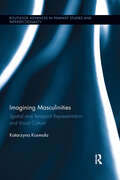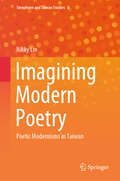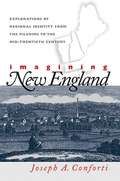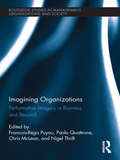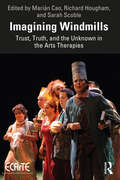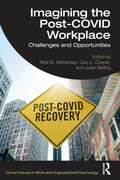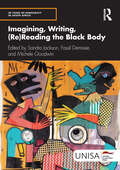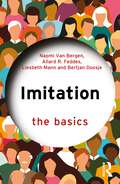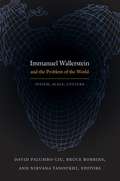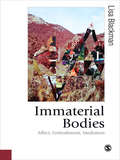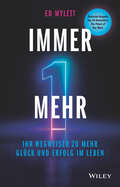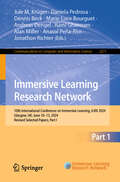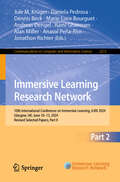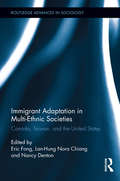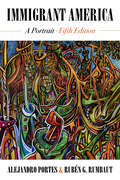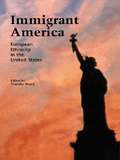- Table View
- List View
Imagining Masculinities: Spatial and Temporal Representation and Visual Culture
by Katarzyna KosmalaThis book examines the intersections between debates in critical studies of men and masculinities and debates on visual representation, investigating representations of men and masculinities in contemporary culture and examples of visual art that deconstruct those representations. It attends to various spaces associated with heteronormativity, including the visible domains of working life, leisure and public discourses, as well as less visible domains such as private spaces, lifestyle, desire and sexual agency.
Imagining Modern Poetry: Poetic Modernisms in Taiwan (Sinophone and Taiwan Studies #8)
by Nikky LinThis book offers an in-depth discussion of the evolution of modernist poetry in Taiwan, with a focus on periods preceding and following World War II, and contextualizes the movement within the broader frameworks of Western, Japanese, and Chinese modernism. Through a comparative, dialectical approach, each chapter introduces individual poets and their works to explore key modernist themes such as intellectualism, fudo, pure poetry, translinguistic practice, exile, Cold War cultural ideology, and irony. Despite its significance, Taiwan’s modern poetry has received inadequate scholarly attention within Sinophone language and literature studies; this work aims to address the gap in the literature, offering fresh perspectives and innovative methodological and theoretical frameworks for those interested in Taiwan’s modernist poetic tradition.
Imagining New England
by Joseph A. ConfortiSay "New England" and you likely conjure up an image in the mind of your listener: the snowy woods or stone wall of a Robert Frost poem, perhaps, or that quintessential icon of the region--the idyllic white village. Such images remind us that, as Joseph Conforti notes, a region is not just a territory on the ground. It is also a place in the imagination. This ambitious work investigates New England as a cultural invention, tracing the region's changing identity across more than three centuries. Incorporating insights from history, literature, art, material culture, and geography, it shows how succeeding generations of New Englanders created and broadcast a powerful collective identity for their region through narratives about its past. Whether these stories were told in the writings of Frost or Harriet Beecher Stowe, enacted in historical pageants or at colonial revival museums, or conveyed in the pages of a geography textbook or Yankee magazine, New Englanders used them to sustain their identity, revising them as needed to respond to the shifting regional landscape.
Imagining Organizations: Performative Imagery in Business and Beyond (Routledge Studies in Management, Organizations and Society)
by Nigel Thrift Paolo Quattrone Francois-Régis Puyou Chris McLeanOrganizations rely extensively upon a myriad of images and pictorial representations such as budgets, schedules, reports, graphs, and organizational charts to name but a few. Visual images play an integral role in the process of organizing. This volume argues that images in organizations are ‘performative’, meaning that they can be seen as performances, rather than mere representations, that play a significant role in all kind of organizational activities. Imagining Organizations opens up new ways of imagining business through an interdisciplinary approach that captures the role of visualizations and their performances. Contributions to this volume challenge this orthodox view to explore how images in business, organizing and organizations are viewed in a static and rigid form. Imagining Business addresses the question of how we visualize organizations and their activities as an important aspect of managerial work, focusing on practices and performances, organizing and ordering, and media and technologies. Moreover, it aims to provide a focal point for the growing collection of studies that explore how various business artifacts draw on the power of the visual to enable various forms of organizing and organizations in diverse contexts.
Imagining Society: The Case for Sociology
by Daniel Nehring Dylan KerriganRe-examining C.Wright Mills’s legacy as a jumping off point, this original introduction to sociology illuminates global concepts, themes and practices that are fundamental to the discipline. It makes a case for the importance of developing a sociological imagination and provides the steps for how readers can do that. The unique text: • Offers succinct and wide-ranging coverage of many of the most important themes and concepts taught in first year sociology courses; • Has a global framework and case material which engages with decoloniality and critiques an overly white, western and developed world view of sociology; • Is woven through with contemporary examples, from social media to social inequality, big data to the self-help industry; • Rethinks and re-imagines what a critically committed, politically engaged and publicly relevant sociology should look like in the 21st century. This is a lively, engaging and accessible overview of sociology for all its students, teachers and people who want to learn more about sociology today. It is a welcome clarion call for sociology’s importance in public life.
Imagining Urban Futures: Cities in Science Fiction and What We Might Learn from Them
by Carl AbbottWhat science fiction can teach us about urban planning Carl Abbott, who has taught urban studies and urban planning in five decades, brings together urban studies and literary studies to examine how fictional cities in work by authors as different as E. M. Forster, Isaac Asimov, Kim Stanley Robinson, and China Miéville might help us to envision an urban future that is viable and resilient. Imagining Urban Futures is a remarkable treatise on what is best and strongest in urban theory and practice today, as refracted and intensely imagined in science fiction. As the human population grows, we can envision an increasingly urban society. Shifting weather patterns, rising sea levels, reduced access to resources, and a host of other issues will radically impact urban environments, while technology holds out the dream of cities beyond Earth. Abbott delivers a compelling critical discussion of science fiction cities found in literary works, television programs, and films of many eras from Metropolis to Blade Runner and Soylent Green to The Hunger Games, among many others.
Imagining Windmills: Trust, Truth, and the Unknown in the Arts Therapies
by Richard Hougham Sarah Scoble Marián CaoImagining Windmills presents a compilation of scholarly chapters by selected authors of global standing in the arts therapies. This book reflects the theme of the 15th International Conference of the European Consortium for Arts Therapies (ECArTE), held in Alcalá de Henares, Spain, birthplace of Miguel de Cervantes. This innovative work seeks to further understanding of arts therapy education, practice and research and incorporates current thinking from art therapists, dance-movement therapists, dramatherapists and music therapists. Writers from Belgium, Germany, Greece, India, Israel, Italy, The Netherlands, Spain, Sweden, UK and USA combine to give an international voice to the book, which celebrates cultural distinctiveness, while also presenting shared intercultural developments in the professions. This interdisciplinary publication explores questions of the unknown and the imagined, misconception, delusion, truth and trust in the arts therapies. It enquires into ways in which education and the practice of the arts therapies engage with the imagination as a place of multiple realities, which may lead us closer to finding our truth. This book will be of interest and relevance not only to those in the arts therapeutic community, but also to a broad audience including those in related professions – for instance psychology, sociology, the arts, medicine, health and wellbeing and education.
Imagining Zion: Dreams, Designs, and Realities in a Century of Jewish Settlement
by S. Ilan TroenThis timely book tells the fascinating story of how Zionists colonizers planned and established nearly 700 agricultural settlements, towns, and cities from the 1880s to the present. This extraordinary activity of planners, architects, social scientists, military personnel, politicians, and settlers is inextricably linked to multiple contexts: Jewish and Zionist history, the Arab/Jewish conflict, and the diffusion of European ideas to non-European worlds. S. Ilan Troen demonstrates how professionals and settlers continually innovated plans for both rural and urban frontiers in response to the competing demands of social and political ideologies and the need to achieve productivity, economic independence, and security in a hostile environment. In the 1930s, security became the primary challenge, shaping and even distorting patterns of growth. Not until the 1993 Oslo Accords, with prospects of compromise and accommodation, did planners again imagine Israel as a normal state, developing like other modern societies. Troen concludes that if Palestinian Arabs become reconciled to a Jewish state, Israel will reassign priority to the social and economic development of the country and region.
Imagining the Past, Constructing the Future
by Brady Wagoner Maria C. D. P. Lyra Alicia BarreiroThis book takes a sociocultural, developmental and dialogical perspective to explore the constructive and interconnected nature of remembering and imagining. Conceived as cognitive-affective processes, both emerge at the border of the person and his or her socio-cultural world. Memory is approached as a functional adaption to the environment using the resources of the past in preparation for action in the present. Imagination is tightly related to memory in that both aim to escape the confines of the concrete here-and-now situation; however, while memory is primarily oriented to the past, imagination looks to the future. Both are embedded in the exchanges with the social and cultural milieu, and thus theorizing them has relied on key ideas from Lev Vygotsky, Frederic Bartlett and Mikhail Bakhtin. Thus, this book aims to integrate theories of remembering and imagining, through rich empirical studies in diverse cultural settings and concerning the development of self and identity. These two groups of studies compose the subparts that organize the book.
Imagining the Post-COVID Workplace: Challenges and Opportunities (Current Issues in Work and Organizational Psychology)
by Cary L. Cooper Neal M. Ashkanasy Julian BarlingImagining the Post-COVID Workplace explores the impact of how work and the workplace have changed as a result of the COVID-19 pandemic, cost of living crisis, worldwide inflation, and potential impending recession.Leading scholars from across the globe consider the challenges and opportunities the pandemic has created for organizations and employees in all aspects of their jobs and working lives. The book follows a narrative from the broad pandemic-induced disruptions to individual and organizational responses, and new work dynamics, culminating in the long-term societal impacts on work and well-being. The chapters examine key trends from organizational psychological topics, including communication, HR strategy, culture, teamwork, leadership, ethics, managing stress and burnout, workplace health and safety, flexible working, the future of careers, and retirement. Brought together, these chapters offer a comprehensive overview of important areas within the field of work and organizational psychology, and how they connect to the post-COVID workplace. The authors provide guidance on embracing agility, resilience, and innovation to thrive in an uncertain and rapidly changing environment.This book is essential reading for professionals looking to understand and redesign their workplace as a result of the changes due to the COVID-19 pandemic, including industry leaders, organizational psychologists, human resource professionals, employers, and managers. It will also interest all students and scholars of work and organizational psychology, and organizational studies, who are interested in the direction of change within the workplace.
Imagining, Writing, (30 Years of Democracy in South Africa)
by Michele Goodwin Fassil Demissie Sandra JacksonThis book is an outgrowth of an international conference – The Black Body: Imagining, Writing, and Re(Reading) – held at DePaul University, Chicago in 2004. The various contributing authors critically examine the changing discourses on the black body to address how it has been constituted as a site for construction and maintenance of social and political power. Drawing examples from Europe, Africa, the United States as well as other places in the Black Diaspora, the subject matter in this book discusses the raced, gendered, classed and culturally produced discourses about the black body. Through its examination of these and related issues, this book contributes to a dialogue across various disciplines about the black body, its meanings and negotiations as read, interpreted, and imagined in different frames of perception and imagination.Print editions not for sale in Sub-Saharan Africa. This book is part of Routledge’s co-published series 30 Years of Democracy in South Africa, in collaboration with UNISA Press, which reflects on the past years of a democratic South Africa and assesses the future opportunities and challenges.
Imitation, Contagion, Suggestion: On Mimesis and Society (CRESC)
by Christian BorchTerrorist attacks seem to mimic other terrorist attacks. Mass shootings appear to mimic previous mass shootings. Financial traders seem to mimic other traders. It is not a novel observation that people often imitate others. Some might even suggest that mimesis is at the core of human interaction. However, understanding such mimesis and its broader implications is no trivial task. Imitation, Contagion, Suggestion sheds important light on the ways in which society is intimately linked to and characterized by mimetic patterns. Taking its starting point in late-nineteenth-century discussions about imitation, contagion, and suggestion, the volume examines a theoretical framework in which mimesis is at the center. The volume investigates some of the key sociological, psychological, and philosophical debates on sociality and individuality that emerged in the wake of the late-nineteenth-century imitation, contagion, and suggestion theorization, and which involved notable thinkers such as Gabriel Tarde, Emile Durkheim, and Friedrich Nietzsche. Furthermore, the volume demonstrates the ways in which important aspects of this theorization have been mobilized throughout the twentieth century and how they may advance present-day analyses of topical issues relating to, e.g. neuroscience, social media, social networks, agent-based modelling, terrorism, virology, financial markets, and affect theory. One of the significant ideas advanced in theories of imitation, contagion, and suggestion is that the individual should be seen not as a sovereign entity, but rather as profoundly externally shaped. In other words, the decisions people make may be unwitting imitations of other people’s decisions. Against this backdrop, the volume presents new avenues for social theory and sociological research that take seriously the suggestion that individuality and the social may be mimetically constituted.
Imitation: The Basics (The Basics)
by Bertjan Doosje Allard R. Feddes Liesbeth Mann Naomi Van BergenImitation: The Basics is an engaging introduction to the topic of imitation behavior in humans, providing a summary of existing scientific research on imitation, covering everything from examples of imitation across each developmental stage to animal imitation such as monkeys imitating each other. The authors argue that imitation forms the foundation of long-lasting relationships, including those between children and parents, as well as intimate partners. Structured to resemble a human lifetime, chapters explore the reasons behind why people imitate, and address imitation across all phases of life, starting from infancy, childhood, adolescence, adulthood and ending with late adulthood. The authors describe characteristic forms of imitation that occur in these life stages and provide answers to the following important questions: Who do humans imitate? Who is more likely to imitate others? What kind of behaviors do humans imitate? Is there a dark side of imitation? When do humans imitate each other? And are there cultural differences in imitation? Written in a clear and accessible style, this book is perfect for undergraduate students of social psychology, developmental psychology and neuroscience, as well as professionals, academics and any general readers interested in research about human social behavior.
Immanuel Kant: Anthropology, History, and Education
by Immanuel Kant Günter Zöller Robert B. LoudenAnthropology, History, and Education, first published in 2007, contains all of Kant's major writings on human nature. Some of these works, which were published over a thirty-nine year period between 1764 and 1803, had never before been translated into English. Kant's question 'What is the human being?' is approached indirectly in his famous works on metaphysics, epistemology, moral and legal philosophy, aesthetics and the philosophy of religion, but it is approached directly in his extensive but less well-known writings on physical and cultural anthropology, the philosophy of history, and education which are gathered in the present volume. Kant repeatedly claimed that the question 'What is the human being?' should be philosophy's most fundamental concern, and Anthropology, History, and Education can be seen as effectively presenting his philosophy as a whole in a popular guise.
Immanuel Wallerstein and the Problem of the World: System, Scale, Culture
by Bruce Robbins David Palumbo-Liu Nirvana TanoukhiIn this collection of essays, leading cultural theorists consider the meaning and implications of world-scale humanist scholarship by engaging with Immanuel Wallerstein's world-systems analysis. The renowned sociologist developed his influential critical framework to explain the historical and continuing exploitation of the rest of the world by the West. World-systems analysis reflects Wallerstein's conviction that understanding global inequality requires thinking on a global scale. Humanists have often criticized his theory as insufficiently attentive to values and objects of knowledge such as culture, agency, difference, subjectivity, and the local. The editors of this collection do not deny the validity of those criticisms; instead, they offer Wallerstein's world-systems analysis as a well-developed vision of the world scale for humanists to think with and against. Scholars of comparative literature, gender, geography, history, law, race, and sociology consider what thinking on the world scale might mean for particular disciplinary practices, knowledge formations, and objects of study. Several essays offer broader reflections on what is at stake for the study of culture in decisions to adopt or reject world-scale thinking. In a brief essay, Immanuel Wallerstein situates world-systems analysis vis--vis the humanities. Contributors. Gopal Balakrishnan, Tani E. Barlow, Neil Brenner, Richard E. Lee, Franco Moretti, David Palumbo-Liu, Bruce Robbins, Helen Stacy, Nirvana Tanoukhi, Immanuel Wallerstein, Kren Wigen
Immaterial Bodies: Affect, Embodiment, Mediation (Published in association with Theory, Culture & Society)
by Dr Lisa BlackmanIn this unique contribution, Blackman focuses upon the affective capacities of bodies, human and non-human as well as addressing the challenges of the affective turn within the social sciences. Fresh and convincing, this book uncovers the paradoxes and tensions in work in affect studies by focusing on practices and experiences, including voice hearing, suggestion, hypnosis, telepathy, the placebo effect, rhythm and related phenomena. Questioning the traditional idea of mind over matter, as well as discussing the danger of setting up a false distinction between the two, this book makes for an invaluable addition within cultural theory and the recent turn to affect. In a powerful and engaging matter, Blackman discusses the immaterial body across the neurosciences, physiology, media and cultural studies, body studies, artwork, performance, psychology and psychoanalysis. Interdisciplinary in its core, this book is a must for everyone seeking a dynamic and thought provoking analysis of culture and communication today.
Immer eins mehr!: Ihr Wegweiser zu mehr Glück und Erfolg im Leben
by Ed MylettDie deutsche Ausgabe des US-Bestsellers: "The Power of One More" - Revolutionäre Strategien, die Ihr Leben für immer verändern werden! Die Prämisse von "Immer eins mehr!" ist einfach. Sie sind dem Leben, von dem Sie träumen, viel näher, als Sie denken. Oft sind Sie nur ein weiteres Treffen, eine weitere Beziehung, eine weitere Entscheidung, eine weitere Handlung oder einen weiteren Gedanken davon entfernt, das Leben zu führen, das Sie verdienen. In diesem bahnbrechenden Buch stellt Ihnen Ed Mylett Dutzende von Strategien vor, die er seit 30 Jahren anwendet, um ein äußerst erfolgreicher Unternehmer, Trainer und weltweit gefragter inspirierender Redner zu werden. Ed Myletts Buch lehrt Sie, wie Sie bewusst Gedanken und Handlungen kombinieren können, um große Veränderungen in Ihrem Leben zu bewirken. Neben neuen Erkenntnissen zu wichtigen Themen wie Führung, Zeitmanagement, Gewohnheiten und Zielsetzung stellt der Autor Ihnen auch neue und einzigartige Konzepte zu den Themen Unmöglichkeit, Gelassenheit und Glaube vor und erklärt, warum Sie Unannehmlichkeiten in Ihrem Leben in Kauf nehmen müssen. Ed Mylett nimmt Sie auch mit auf eine sehr persönliche Reise, auf der er die Beziehung zwischen ihm und seinem Vater schildert und wie sein Vater ihm eine der unbezahlbarsten Lektionen des Lebens beigebracht hat: die Kraft von "One Last One More". Die Strategien des Buches sind universell. Sie können sie in Ihr Leben integrieren, ganz gleich, ob Sie ein CEO oder ein Weltklasse-Sportler sind, oder ob Sie bessere Beziehungen zu Ihrer Familie und Ihren Freunden aufbauen wollen. Perfekt für jeden, der nach mehr Glück und Erfolg strebt, ist "Immer eins mehr!" Ihr unverzichtbarer Wegweiser zu einem besseren Leben.
Immersed in Media: Telepresence in Everyday Life (Routledge Communication Series)
by Cheryl Campanella Bracken"Over the next few decades, immersive media could fundamentally change the ways humans engage in entertainment, communication, and social interaction. The current volume takes a step towards understanding this potential paradigm shift, combining insights from pioneers of the field of ‘presence’ with bright young scholars who bring a new perspective." —Jeremy Bailenson, Stanford University, USA "This book provides an indispensable contribution to scholars in communication studies, computer science and psychology interested in the modes of being present in different media, and offers a careful historical and theoretical framework to the state-of-the-art research."—Anna Spagnolli, University of Padova, Italy "Bracken and Skalski have assembled a collection of works from the world’s foremost authorities on telepresence, a topic that has gone understudied for years. Someone has finally assembled a comprehensive volume on the subject. This book is a must not only for those interested in telepresence, but for mass communication scholars of all kinds."—Kenneth A. Lachan, University of Massachusetts, Boston, USA Immersed in Media highlights the increasing significance of telepresence in the media field. With contributions representing diverse disciplines, this volume delves into the topic through considerations of popular media types and their effects on users. Chapters in the work explain how the experience of presence can be affected by media technologies, including television, video games, film, and the Internet. They also discuss how presence experience mediates or moderates commonly studied media effects, such as enjoyment, persuasion, and aggression. These discussions are accompanied by overviews of the current state of presence research and its future. Ultimately, this work establishes the crucial role of telepresence in gaining a complete understanding of the uses and effects of popular media technologies.
Immersive Learning Research Network: 10th International Conference on Immersive Learning, iLRN 2024, Glasgow, UK, June 10–13, 2024, Revised Selected Papers, Part I (Communications in Computer and Information Science #2271)
by Dennis Beck Jonathon Richter Alan Miller Anasol Peña-Rios Andreas Dengel Rami Ghannam Marie-Luce Bourguet Jule M. Krüger Daniela PedrosaThis book constitutes the proceedings of the10th International Conference on Immersive Learning, iLRN 2024, held in Glasgow, UK during June 10–13, 2024. The 30 full papers and 13 short papers presented in this volume were carefully reviewed and selected from 144 submissions. They were categorized under the topical section as follows: Part I: Foundations in Immersive Learning Research and Theory; Assessment and Evaluation (A&E); Galleries, Libraries, Archives and Museums (GLAM); Inclusion, Diversity, Equity, Access, and Social Justice (IDEAS); STEM Education (STEM); Medical & Healthcare Education (MHE); Workforce Development & Industry Training (WDIT); Self and Co-regulated Learning with Immersive Learning Environments (SCILE). Part II: Special Track 1: Immersive learning across Latin America: State of Research, Use Cases and Projects; Special Track 2: Sustainable Development and Immerse Learning in the Climate Emergency; Special Track 3: Literacy Equity and Immersive Learning.
Immersive Learning Research Network: 10th International Conference on Immersive Learning, iLRN 2024, Glasgow, UK, June 10–13, 2024, Revised Selected Papers, Part II (Communications in Computer and Information Science #2272)
by Dennis Beck Jonathon Richter Alan Miller Anasol Peña-Rios Andreas Dengel Rami Ghannam Marie-Luce Bourguet Jule M. Krüger Daniela PedrosaThis book constitutes the proceedings of the10th International Conference on Immersive Learning, iLRN 2024, held in Glasgow, UK during June 10–13, 2024. The 30 full papers and 13 short papers presented in this volume were carefully reviewed and selected from 144 submissions. They were categorized under the topical section as follows: Part I: Foundations in Immersive Learning Research and Theory; Assessment and Evaluation (A&E); Galleries, Libraries, Archives and Museums (GLAM); Inclusion, Diversity, Equity, Access, and Social Justice (IDEAS); STEM Education (STEM); Medical & Healthcare Education (MHE); Workforce Development & Industry Training (WDIT); Self and Co-regulated Learning with Immersive Learning Environments (SCILE). Part II: Special Track 1: Immersive learning across Latin America: State of Research, Use Cases and Projects; Special Track 2: Sustainable Development and Immerse Learning in the Climate Emergency; Special Track 3: Literacy Equity and Immersive Learning.
Immersive Learning Research Network: 11th International Conference, iLRN 2025, Chicago, IL, USA, June 15–19, 2025, Revised Selected Papers (Communications in Computer and Information Science #2598)
by Dennis Beck Jonathon Richter Anasol Peña-Rios Matthew Schmidt Anastasios Mikropoulos Genevieve Smith-Nunes Jule M. Krüger Daniela Pedrosa George Koutromanos Stylianos MystakidisThis book constitutes the revised selected papers of the 11th International Conference on Immersive Learning, iLRN 2025, held in Chicago, IL, USA, during June 15–19, 2025. The 23 full papers presented in this volume were carefully reviewed and selected from 57 submissions. They were categorized under the topical sections as follows: Foundations in Immersive Learning Research and Theory; Assessment and Evaluation (A&E); Inclusion, Diversity, Equity, Access, and Social Justice (IDEAS); STEM Education (STEM); Medical & Healthcare Education (MHE); Workforce Development & Industry Training (WDIT); Self and Co-regulated Learning with Immersive Learning Environments (SCILE); Special Track 1: Immersive learning across Latin America: State of Research, Use Cases and Projects; Special Track 2: Navigating Grand Challenges: Immersive Learning & Global Solutions (iLRNGrandChallenges); and Special Track 3: Sustainable Development and Immerse Learning in the Climate Emergency.
Immigrant Adaptation in Multi-Ethnic Societies: Canada, Taiwan, and the United States (Routledge Advances in Sociology #78)
by Nancy Denton Eric Fong Lan-Hung Nora ChiangAs a result of international immigration, ethnic diversity has increased rapidly in many countries, not only in major cities, but also in smaller cities. This trend is not limited to the traditional immigrant receiving countries, such as the United States and Canada, but occurs also in many other countries where doors are gradually opening to immigration, especially in Asia. This combination of a growing immigrant population and ethnic diversity has fostered a more complex immigrant integration process. This book addresses the subject at the city ecological level, inter-group level, and individual level. It contributes to the understanding of immigrant adaptation in a multi-ethnic context, brings Asian perspectives into the discussion of immigration and race and ethnic relations, and will serve as a basis for future study of immigrant adaptation in a multi-ethnic context.
Immigrant Ambassadors: Citizenship and Belonging in the Tibetan Diaspora
by Julia Meredith HessHess (anthropology, U. of New Mexico) examines articulations of Tibetanness among stateless Tibetans in India and among Tibetans resettled in the United States and in the process of becoming US citizens. She describes a transformation of diaspora consciousness among the Tibetans giving up their stateless status and adopting US citizenship through an examination of Tibetan responses to the bureaucratic processes required to procure identity documents, travel documents, visas, asylum applications, citizenship ceremonies, and passports. She finds that the Tibetans involved in the Tibetan US Resettlement Project invest citizenship with multiple meanings and that many are adopting US citizenship in an effort to become more effective transnational political actors in the cause of an independent Tibet. Annotation ©2009 Book News, Inc. , Portland, OR (booknews. com)
Immigrant America: A Portrait
by Prof. Alejandro Portes Prof. Rubén G. RumbautThis revised and updated fifth edition of Immigrant America: A Portrait provides a comprehensive and current overview of immigration to the United States, including its history, the principal theories seeking to account for its diverse origins, the main types of immigrants, and the various forms of immigrants' incorporation within American society. With the latest available data, Immigrant America further explores the economic, political, regional, linguistic, and religious aspects of immigration. It offers detailed analyses of the adaptation process experienced by adult children of immigrants and adds an updated and expanded concluding chapter on changing immigration policy regimes both past and present.
Immigrant America: European Ethnicity in the U.S.
by Timothy WalchThis new volume of original essays focuses on the presence of European ethnic culture in American society since 1830. Among the topics explored in Immigrant America are the alienation and assimilation of immigrants; the immigrant home and family as a haven of ethnicity; religion, education and employment as agents of acculturation; and the contours of ethnic community in American society.
